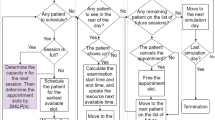Abstract
Clinics that provide pediatric care are frequently confronted with family group appointment requests, where parents desire their children to be scheduled simultaneously or consecutively. This is potentially beneficial to the family by minimizing the number of trips to the provider’s office. However, offering prescheduled group appointments have the risk of reducing provider utilization, particularly if the entire group fails to meet their scheduled appointment. Similarly, reserving appointment slots for same day group appointment requests may also decrease utilization and impact profitability. This paper explores the impact of family group appointments on clinic performance in terms of provider utilization and profit. A finite-horizon, stochastic dynamic programming problem is presented to determine the optimal scheduling strategy given both individual and group appointment requests can be tactically accommodated via overbooking. On the basis of a computational study, we quantify the risk to clinic profitability and productivity resulting from the no-show behavior of prescheduled appointments. We also characterize the behavior of the optimal scheduling strategy as a function of prescheduled appointment allocations among the patient classes.





Similar content being viewed by others
References
Abdus-Salaam H and Davis L (2012) Impact of batch appointments on no-show rates: a public vs private clinic perspective. Health Systems 1 (1), 36–45.
Bailey N (1952) A study of queues and appointment systems in hospital out-patient departments, with special reference to waiting-times. Journal of the Royal Statistical Society. Series B (Methodological) 14 (2), 185–199.
Cayirli T and Veral E (2003) Outpatient scheduling in health care: a review of literature. Production and Operations Management 12 (4), 519–549.
Chakraborty S, Muthuraman K and Lawley M (2010) Sequential clinical scheduling with patient no-shows and general service time distributions. IIE Transactions 42 (5), 354–366.
Gupta D and Wang L (2008) Revenue management for a primary-care clinic in the presence of patient choice. Operations Research 56 (3), 576–592.
Harper PR and Gamlin HM (2003) Reduced outpatient waiting times with improved appointment scheduling: a simulation modelling approach. OR Spectrum 25 (2), 207–222.
Kim S and Giachetti RE (2006) A stochastic mathematical appointment overbooking model for healthcare providers to improve profits. IEEE Transactions on Systems, Man & Cybernetics: Part A 36 (6), 1211–1219.
Klassen KJ and Rohleder TR (1996) Scheduling outpatient appointments in a dynamic environment. Journal of Operations Management 14 (2), 83–101.
Kros J, Dellana S and West D (2009) Overbooking increases patient access at East Carolina university's student health services clinic. Interfaces 39 (3), 271–287.
LaGanga LR and Lawrence SR (2007) Clinic overbooking to improve patient access and increase provider productivity. Decision Sciences 38 (2), 251–276.
Liu N, Ziya S and Kulkarni V (2010) Dynamic scheduling of outpatient appointments under patient no-shows and cancellations. Manufacturing & Service Operations Management 12 (2), 347–364.
Muthuraman K and Lawley M (2008) A stochastic overbooking model for outpatient clinical scheduling with no-shows. IIE Transactions 40 (9), 820–837.
Pierskalla WP and Brailer DJ (1994) Applications of operations research in health care delivery. In Handbooks in Operations Research and Management Science, 6:Operations Research and the Public Sector (Pollock SM, Rothkopf MH and Barnett A, Eds), pp 469–505, Elsevier Science, Amsterdam, The Netherlands.
Zeng B, Turkcan A, Lin J and Lawley M (2010) Clinic scheduling models with overbooking for patients with heterogeneou no-show probabilities. Annals of Operations Research 178 (1), 121–144.
Zeng B, Zhao H and Lawley M (2009) Clinic overbooking and patient response: a game theoretic approach. In Proceedings of the 2009 Industrial Engineering Research Conference (Smith JC and Geunes J, Eds), pp 785–790, Institute of Industrial Engineers: Miami, FL.
Author information
Authors and Affiliations
Appendix
Appendix
Newsvendor solution to the allocation of slack capacity
We define the following notation before proceeding with the formal presentation of our results. Let s represent the slack capacity; d the demand for capacity (number of overbooked patients waiting for service); f(ɛ) the probability density function associated with the slack capacity; φ(·) is the cumulative distribution function; p1 the penalty for excess capacity; and p2 the penalty for insufficient capacity. Since prescheduled appointments will never exceed the physician’s capacity, we can examine the additional profit obtained via overbooking as a function of the slack capacity and the demand for capacity. The expected profit is defined as follows.

The first two terms represent the expected revenue obtained as a function of the number of patients overbooked and the slack capacity. The third term represents the expected penalty due to excess capacity. The fourth term represents the expected penalty due to insufficient capacity.
The expected profit function can be simplified to the following expression.

where μ is the expected slack capacity E[ɛ].

Setting G′(d)=0 yields the following.

The solution of the equation above maximizes the profit function since G(d) is concave.

A similar argument can be made using marginal analysis when the slack capacity is defined by a discrete distribution. In particular, the number of patients to overbook is the largest number d satisfying

Optimal number to overbook in the last decision epoch
The terminal period is a one-period problem with no decision. Using marginal analysis, we analyze the behavior of the profit function g(s, d).
- Case 1.:
-
If s⩽d Profit will be rs−p2(d−s)+(r−p2)(d−s)=rd−2p2d+2p2s The change in profit from overbooking one additional patient increases since

- Case 2.:
-
If s⩾d, Profit will be r(d+1)−p1(s−d+1))=rd+r−p1s+p1d−p1=(r+p1)d+(r+p1)−p1s

The expected change in profit from overbooking one additional patient is always increasing since

As a result, it is better to end the period with some patients overbooked. In our problem since we have an overbooking limit policy variable, the number of patients to overbook is bounded and thus the expected profit is bounded. The value of d is decided in the prior period. In time period t=T−1, (assuming no decision is made in the terminal period) the selection of the number to overbook is made in advance of time T based on the slack capacity in period T.
Rights and permissions
About this article
Cite this article
Abdus-Salaam, H., Davis, L. Tactical allocation and acceptance of multiple patient classes in the presence of no-shows. Health Syst 4, 93–103 (2015). https://doi.org/10.1057/hs.2014.18
Received:
Revised:
Accepted:
Published:
Issue Date:
DOI: https://doi.org/10.1057/hs.2014.18







